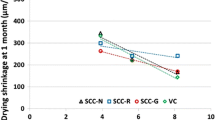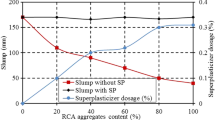Abstract
Shrinkage behavior of self-compacting concrete (SCC) can be different from that of traditional vibrated concrete, because of different paste and aggregate volumes. For traditional concrete, shrinkage can be estimated based on shrinkage results obtained on paste level. Based on homogenization techniques, Le Roy developed a model relating the shrinkage of concrete to the shrinkage of the representative cement paste, considering a granular coefficient taking into account the elastic properties and the concentration of the aggregates. By means of an extended experimental program, the applicability of this model to the case of SCC has been verified. Furthermore, some known results on the influence of water/cement ratio and filler/cement ratio have been confirmed and can be explained by porosity results.















Similar content being viewed by others
References
De Schutter G, Bartos P, Domone P, Gibbs J (2008) Self-compacting concrete. Whittles Publishing, Caithness, 296p
Leemann A, Hoffmann C (2005) Properties of self-compacting concrete and conventional concrete, differences and similarities. Mag Concrete Res 57(6):315–319
Loser R, Leemann A (2009) Shrinkage and restrained shrinkage cracking of selfcompacting concrete compared to conventionally vibrated concrete. Mater Struct 42(1):71–82
Mounanga P (2004) Étude expérimentale du comportement de pâtes de ciment au très jeune âge: hydratation, retraits, propriétés thermophysiques (in French), Doctoral thesis, University of Nantes, France
Hua C, Barbieri B, (1998) Comparaison des retraits des bétons autonivelants et d’un béton fluide traditionnel. Science des matériaux et propriétés des bétons, pp 265–272, 1ère Rencontre Internationale, Toulouse, 5-6 mars 1998
Graeye B, De Schutter G, Desmet B, Vantomme J, Heirman G, Vandewalle L, Cizer O, Aggoun S, Kadri EH (2010) Effect of mineral filler type on autogenous shrinkage of selfcompacting concrete. Cem Concr Res 40(6):908–913
Sakata K (1993) Prediction of drying shrinkage and creep of the concrete. Concr J 31(2):5–14
Grondin F, Bouasker M, Mounanga P, Khelidj A, Perronnet A (2010) Physico-chemical deformations of solidifying cementitious systems: multiscale modelling. Mater Struct 43(1):151–165
Pichler C, Lackner R, Mang H (2007) A multiscale micromechanics model for the autogenous-shrinkage deformation of early-age cement-based materials. Eng Fract Mech 74:34–58
Gawin D, Pesavento F, Schrefler BA (2007) Modelling creep and shrinkage of concrete by means of effective stresses. Mater Struct 40(6):579–591
Liu JX, Zhao ZY, Deng SC, Liang NG (2009) A simple method to simulate shrinkage-induced cracking in cement-based composites by lattice-type modelling. Comput Mech 43(4):477–492
Le Roy R (1995) Déformations instantanées et différées des bétons à hautes performances (in French), Doctoral thesis, Ecole National des Ponts et Chaussées, Paris, France
Le Roy R, De Larrard F (1993) Concrete: a three phase material—discussion. Cem Concr Res 24(1):189–193
Eguchia K, Teranishib K (2005) Prediction equation of drying shrinkage of concrete based on composite model. Cem Concr Res 35(3):483–493
Almudaiheem JA (1992) An improved model to predict the ultimate shrinkage of concrete. Mag Concr Res 44(159):81–85
Hashin Z (1962) The elaxtic moduli of heterogeneous materials. J Appl Mech 29:143–150
Kheirbek A (2000) Influence des paramètres de formulation sur les retraits endogène et de dessiccation de la pâte de ciment (in French), Doctoral thesis, Université of Cergy-Pontoise, France
Haddad O, Aggoun S, Nachbaur L, Waller V, Cabrillac R (2005) Extension de la méthode Mortiers Bétons Equivalents aux BAP. Annales du Bâtiment et des Travaux Publics, No 5, octobre 2005, 13–17
Waller V, Haddad O, Nachbaur L, Aggoun S (2005) Estimating SCC early ages strength through simple tests. In: The Second North American conference on the design and use of Self-Consolidating Concrete (SCC05), October 30–November 2, Chicago, Illinois, 757–763
Miao C, Tian Q, Sun W, Liu JP (2007) Water consumption of the early-age paste and the determination of “time-zero” of self-desiccation shrinkage. Cem Concr Res 37(11):1496–1501
Jaouadi I (2008) Etude numérique et expérimentale du retrait endogène de la pâte de ciment au jeune âge (in French), Doctoral thesis, Ecole Polytechnique Fédérale de Lausanne, Lausanne, Switzerland
Loukili A (1996) Etude du retrait et du fluage des Bétons à Ultra-Hautes Performances (in French), Doctoral thesis, Université of Nantes, France
Nawa T, Horita T (2004) Autogenous shrinkage of high-performance concrete. In: Proceeding of the international workshop on microstructure and durability to predict service life of concrete structures Sapporo, Japan, Feb 2004
Tazawa E, Miyazawa S (1998) Effect of constituents and curing conditions on autogenous shrinkage of concrete. In: Proceeding of the international workshop on autogenous shrinkage of concrete. 13–14 June, Hiroshima, Japan, 257–268
Tazawa E, Miyazawaa S (1995) Influence of cement and admixture on autogenous shrinkage of cement paste. Cem Concr Res 25(2):281–287
Hua C (1992) Analyse et modélisation du retrait d’autodessiccation de la pâte de ciment durcissant (in French), Doctoral thesis, Ecole National des Ponts et Chaussées, Paris, France
Poppe AM (2004) Influence of fillers on hydration and properties of self-compacting concrete (in Dutch), Doctoral thesis, Magnel Laboratory for Concrete Research, Ghent University Belgium
Pigeon M, Toma G, Marchand J, Bissonnette B (2003) Experimental study of early age restrained autogenous shrinkage. Mater Struct 36(10):666–672
Poppe A-M, De Schutter G (2005) Cement hydration in the presence of high filler contents. Cem Concr Res 35(10):2290–2299
Ye G, Liu X, De Schutter G, Poppe A-M, Taerwe L (2007) Influence of limestone powder used as filler in SCC on hydration and microstructure of cement pastes. Cem Concr Compos 29(2):94–102
Ye G, Liu X, Poppe A-M, De Schutter G, Van Breugel K (2007) Numerical simulation of the hydration process and the development of microstructure of self-compacting cement paste containing limestone as filler. Mater Struct 40(9):865–875
Rozière E, Granger S, Turcry Ph, Loukili A (2007) Influence of paste volume on shrinkage cracking and fracture properties of self-compacting concrete. Cem Concr Compos 29(8):626–636
Caquot A. (1935) role des materiaux inertes dans le béton. Mém. Soc. Ingén. Civils France
Bonavetti VL, Rahal VF, Irassar EF (2001) Studies on the carboaluminate formation in limestone filler-blended cements. Cem Concr Res 31(6):853–859
Feldman R, Ramachandran V, Sereda P (1965) Influence of CaCO3 on the Hydration of 3CaO·Al2O3. J Am Ceram Soc 48(1):25–30
Le Roy R, De Larrard F (2006) bétons autoplaçants, déformations instantanées et différées. Avis Technique 3/05-446, CSTB (Centre Scientifique et Technique du Batiment), 2006
Hua C, Acker P, Ehrlacher A (1995) Analyses and models of the autogenous shrinkage of hardening cement paste: I. Modelling at macroscopic scale. Cem Concr Res 25(7):1457–1468
Hua C, Ehrlacher A, Acker P (1997) Analyses and models of the autogenous shrinkage of hardening cement paste: II. Modelling at scale of hydrating grains. Cem Concr Res 27(2):245–258
Bazǎnt Z, Raftshol W (1982) Effect of cracking in drying and shrinkage specimens. Cem Concr Res 12(2):209–226
Author information
Authors and Affiliations
Corresponding author
Rights and permissions
About this article
Cite this article
Alrifai, A., Aggoun, S., Kadri, EH. et al. Influence of aggregate skeleton on shrinkage properties: validation of the model developed by Le Roy for the case of self-compacting concrete. Mater Struct 44, 1593–1607 (2011). https://doi.org/10.1617/s11527-011-9721-1
Received:
Accepted:
Published:
Issue Date:
DOI: https://doi.org/10.1617/s11527-011-9721-1




